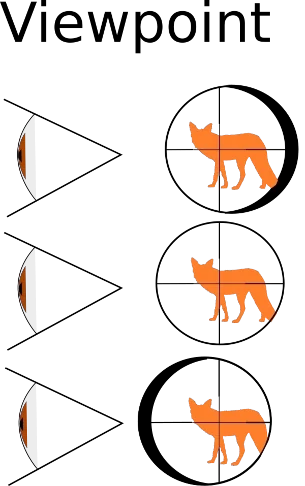

Parallax
Parallax is the apparent difference in the position of an object when it is viewed from different lines of sight. This can have a marked difference in accuracy using scopes.
Table of Contents
Parallax or parallax error is a phenomenon that occurs when the apparent difference in the position of an object is viewed from different lines of sight.
An everyday example of this is in a car with a speedometer that has a needle to indicate the speed. To the driver the markings on the speedo are directly behind the needle therefore, by design, gives the most accurate reading of the speed indicated. In the passenger seat there may be another set of eyes looking at said instrument. Due to parallax (viewed from a different line of sight) the indication may appear higher or, if you drive on the right side the road where you live, it may appear lower.
This can have a marked difference in accuracy using scopes at longer ranges. We’ll look at the concept of parallax and how it affects rifle shots in this article. We’ll also go over how to compensate for parallax error and achieve the highest level of accuracy possible.
Parallax - Reticles and focal planes
The reticle at the Second Focal Plane

The trick to parallax is focusing the reticle, which is about six inches from the shooters eye, and the objective (target), which is maybe 100 yards away. Try holding both of your thumbs out in front of you. Place one thumb at arms length and the other thumb right behind it about half way to your eye. Now, you should have your thumbs lined up in front of your eyes about a foot apart. If you move your head from left to right you will notice that the thumb closest to you appears to move across the image of the front thumb. That’s parallax. The front thumb represents the objective and the thumb closest you represents the reticle. The distance between the thumbs represents two optical planes.
Leupold Scopes
Note: As the image changes note that the crosshairs move also!

The reticle at the First Focal Plane

Now try putting your thumbs side by side. When you move your head now you will see that neither thumb move in relation to the other. This is because they are both in the same optical plane. Notice that we don’t say that they are both in focus. It is possible to have no parallax even if the objective and the reticle are out of focus and appear fuzzy. What is critical to parallax is having both images on the same optical plane, wherever that plane may be as far as focus is concerned.
Leupold Scopes
Note: As the image changes in this case note that the crosshairs remain in their original position!

Parallax - How to correct it
Methods of adjusting parallax on scopes with adjustable focus
Optics only have the ability to see clearly (focus) at one distance. The are various methods employed to adjust focus in a scope:
- Adjustable Objective Lens(AO)
- Adjusted by the Adjustable Objective Ring
- Side focus lens
- Located between the objective lens and erecting lenses
- Adjusted by the Parallax or Side Focus Turret
- Rear focus lens
- Located between the erecting lenses and the ocular lens
- Adjusted by the Rear Focus Ring
- Ocular lens
- Eyepiece or Diopter Focus Ring
The first three methods focus the object. Whereas the last method (4) brings the reticle into focus.

The diopter or eyepiece (reticle) should always be focused first. This will vary from person to person. If you do not start with focusing the reticle then whatever you do to focus on the object will be highly unlikely to achieve a satisfactory result.
Tim
Scopes without adjustable parallax or focus
Typically, scopes without adjustable parallax or focus are used at ranges within 200m (a usual hunting scenario) and are of lower magnification (zoom). In these ranges the effect of parallax is much less. Furthermore, scopes with a fixed objective have a very wide field of focus. The objective focus is set by the manufacturer and can be from 50m to 200m.
It really is a matter for horses for courses. If you are operating with low zoom and at small ranges, adjustable focus scopes may be an expense you can do without. On the other hand if you are operating at bigger distances then some form of adjustable focus is probably a very worthy addition.
Key takeaways
- Always focus the diopter or eyepiece (reticle) before you touch anything else.
- Scopes with the reticle at the FFP do not need parallax adjustment
- The most common reticle location is at the SFP
- The Adjustable Objective Lens (AO) is the most common focal adjustment
- The further the range the larger the parallax error.